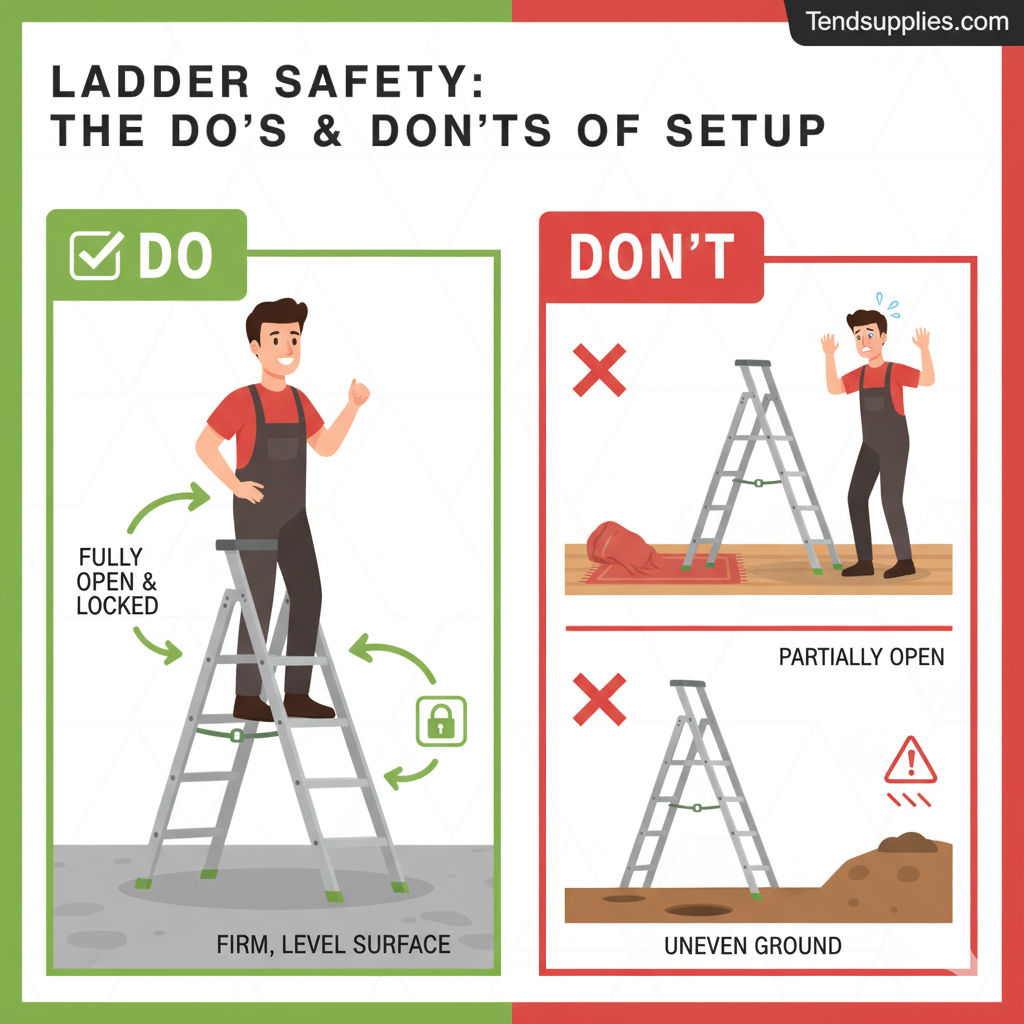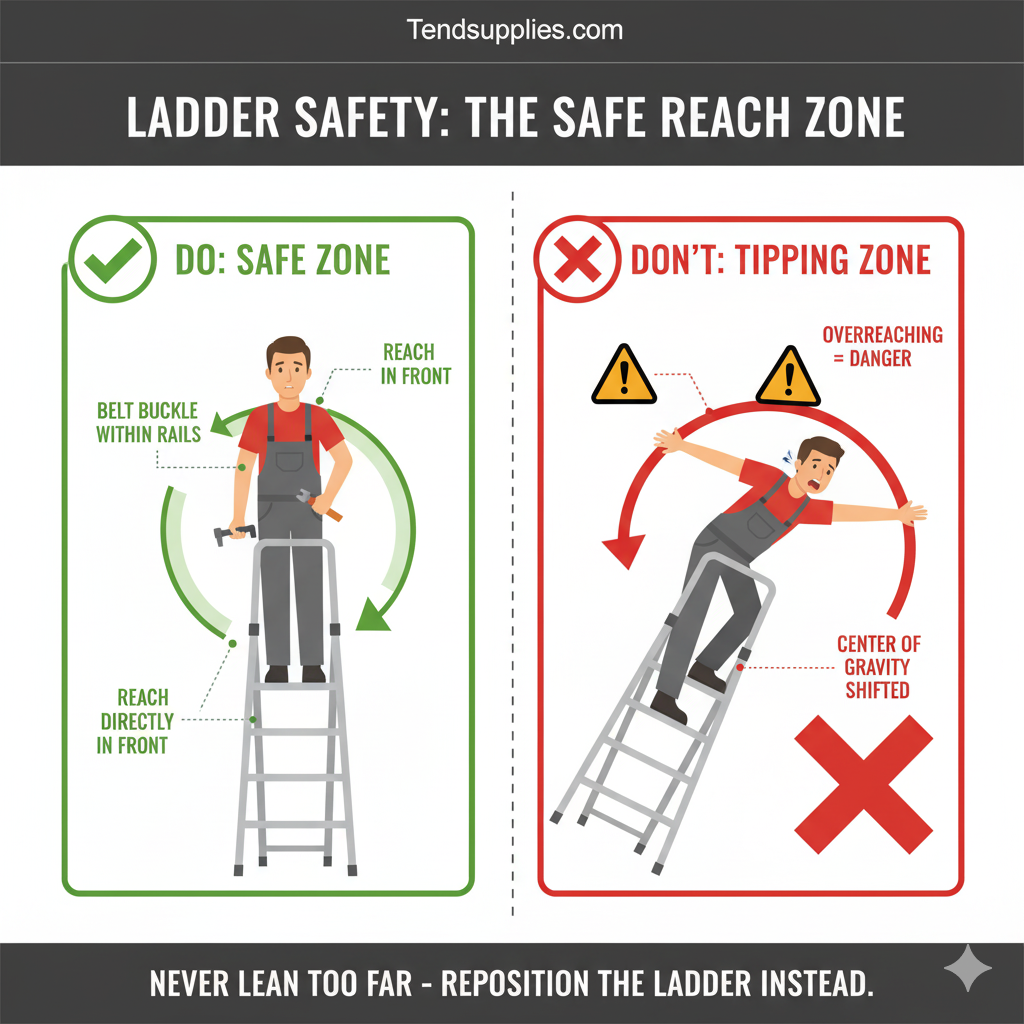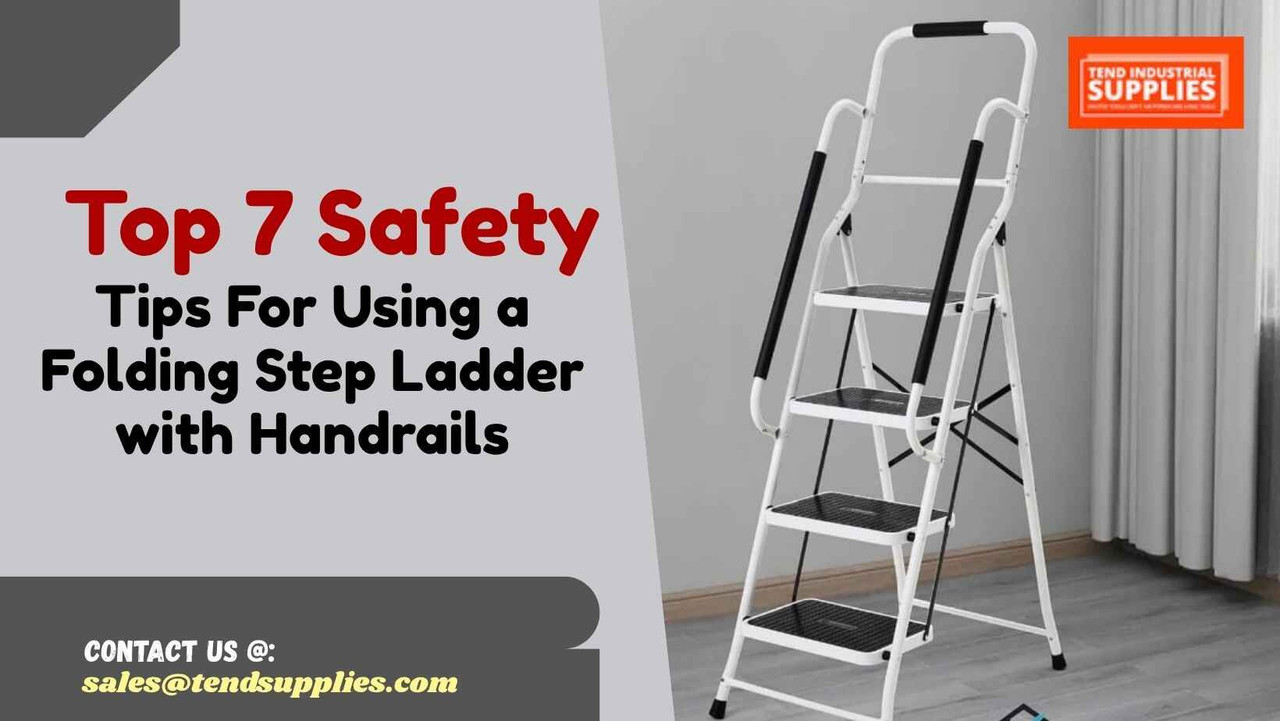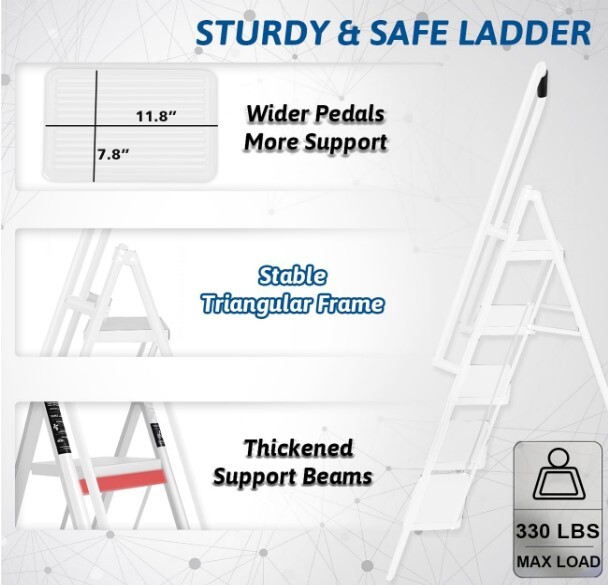Top 7 Safety Tips For Using a Folding Step Ladder with Handrails
It began as a simple Saturday chore, Sarah just wanted to swap out a flickering ceiling light. She unfolded her 5-step folding ladder with handrails, feeling secure as she climbed. But just as she reached for the bulb, the ladder shifted slightly, the rug beneath had slipped. What started as a quick fix could’ve ended with a dangerous fall.
Sarah’s story is a powerful reminder: even the most stable tools demand safe habits. A folding step ladder with handrails is one of the best household investments for both DIY enthusiasts and homeowners. It offers the perfect blend of stability, reach, and safety, especially for tasks just out of arm’s length, like hanging curtains, painting, or organizing high cabinets.
However, while handrails provide extra support and balance, they can also create a false sense of security. The truth is, even with a sturdy design, the fundamental ladder safety rules still apply.
That’s why this guide, Top 7 Safety Tips for Using a Folding Step Ladder with Handrails, walks you through the essential, globally recognized safety practices you should follow every time. Whether you’re in a small New York apartment, a Sydney townhouse, or a Berlin workshop, these steps will help you climb smarter, safer, and with complete confidence.
Amazon Affiliate Disclosure:
Tend Supplies is a participant in the Amazon Services LLC Associates Program, an affiliate advertising program designed to provide a means for sites to earn fees by linking to Amazon.com and affiliated sites. As an Amazon Associate, we earn from qualifying purchases. We only recommend products we genuinely believe in, which helps us continue to create valuable content for our readers.
Key Takeaways:
- Inspect Before Use: Always perform a 30-second check. Ensure the handrails are tight, the folding locks "click" into place, and there are no cracks or damage.
- The Ground is Golden: Only set up your ladder on a solid, flat, and level surface. Never use it on rugs, uneven ground, or slippery floors.
- Don't Overreach: Keep your "belt buckle" (your center of gravity) centered between the ladder's side rails. It's safer to climb down and move the ladder than to lean and risk a tip-over.
- Use the Handrails Correctly: Maintain 3 points of contact (e.g., two feet and one hand on a rail) when climbing. Avoid carrying items that prevent you from holding the rails.
- Check Weight and Footwear: Respect the ladder's maximum weight limit (which includes you plus your tools). Always wear secure, non-slip shoes, never socks or sandals.
Why Safety Matters: Beyond the Handrails
Folding step ladders with handles are designed to be an improvement over traditional A-frame stools. The handrails are there to help you maintain balance while climbing and standing. But the ladder's folding mechanism, the ground it stands on, and the way you use it are all critical factors that determine your safety. Let's break down the essential practices for using a step ladder safely at home or at work.
Tip 1. The Pre-Use Inspection: Your 30-Second Safety Check
Never use any ladder without a quick inspection. This 30-second check can prevent a catastrophic failure. Before you even unfold it, do a quick visual and tactile check.
Check for Dents, Cracks, or Rust
Inspect the ladder's feet, rungs (steps), and the handrails themselves. Any sign of bending, cracking, or significant rust (on metal ladders) means the ladder's integrity could be compromised. Do not use it.
Inspect the Folding Mechanism and Locks
This is the most critical part of a folding ladder. Open and close it once. Do the hinges move smoothly? Most importantly, when the ladder is fully open, do the safety locks or braces engage properly? You should often hear or feel a "click" when it's securely in place. Never use a ladder whose locks don't engage.
Test the Handrails
Grab the handrails and give them a firm wiggle. They should be securely bolted to the frame. If they feel loose or wobbly, tighten the fastenings before use.
Tip 2. Master the Setup: Position is Everything
Where and how you set up your ladder is the single most important factor in preventing falls.
Find Solid, Level, and Clean Ground
This is the golden rule of ladder safety.
- DO: Place your ladder on a hard, flat, level surface (e.g., hardwood, tile, concrete, level pavement).
- DON'T: Never set up a ladder on soft, uneven, or slippery surfaces. This includes rugs, wet grass, or unstable paving stones. A rug can slip, and uneven ground can cause the ladder to tip easily.
Ensure the Ladder is Fully Open
This is a common mistake using a folding step stool. The ladder must be opened to its full extent, and the locking mechanism or spreader bars must be fully engaged. A partially open ladder is dangerously unstable.
Check Your Surroundings
Look up and around. Are you near a ceiling fan you might hit? Are you setting up in a high-traffic hallway where someone might knock into you? Ensure you have a clear, safe workspace.

Tip 3. Maintain 3 Points of Contact (Adapted for Handrails)
The "3-point contact" rule is a global safety standard. It means you should always have either two feet and one hand, or two hands and one foot, in contact with the ladder.
How Handrails Make This Easier
The handrails are designed for this. When climbing up or down, keep at least one hand (preferably two) on the handrails. Face the ladder as you ascend and descend—never turn your back to it.
Carrying Tools and Materials
This is where people get into trouble. If your hands are full, you cannot maintain 3-point contact.
- Use a tool belt.
- Wear a vest with pockets.
- Make two trips. Never try to climb a ladder while carrying a heavy box, a can of paint, or a handful of tools. Use one hand for the rail and the other to carry a light item only if absolutely necessary, or better yet, have someone hand items to you.
Tip 4. Respect the Weight Limit (Yours + Your Gear)
Every folding step ladder has a maximum weight capacity or "duty rating." This is a crucial piece of information, usually found on a sticker on the ladder's side.
Know Your Ladder's Duty Rating
These ratings (e.g., Type III - Light Duty, Type I - Heavy Duty) tell you the maximum load in pounds or kilograms.
Calculate the Total Load
The weight limit is not just your body weight. It is the combined weight of:
- You
- Your clothing and work boots
- Your tools (tool belt)
- The materials you are holding or retrieving (e.g., a heavy box from a shelf)
Never exceed this total weight. If you're close to the limit, get a ladder with a higher rating.
Tip 5. Avoid the "Big 3" Dangerous Moves
Even with handrails, your body's position on the ladder is key. Avoid these three common, high-risk behaviors.
The Dangerous Overreach
This is the #1 cause of step ladder falls. People lean just a little further to reach something, shifting their center of gravity outside the ladder's base.
- The Rule: Keep your "belt buckle" (your center of gravity) centered between the ladder's side rails.
- The Solution: If you can't reach, don't lean. Climb down, and safely move the entire ladder. It takes 10 seconds and saves you from a hospital visit.
The Top Step Temptation
Never stand on the top step or top platform unless the manufacturer's instructions explicitly state it is a designated standing platform. Most handrails end at the second-to-last step, which is your signal that this is the highest safe standing level. Standing on the top removes all your stability and eliminates the benefit of the handrails.
The Side-On Shuffle
Always face the ladder when you are working. Do not stand on a step and twist your body to work "side-on." This sideways force can easily tip the ladder over.

Tip 6. Wear the Right Gear (Yes, Even Indoors)
What you wear matters, even for a quick five-minute job.
Footwear is Non-Negotiable
The best way to maintain a secure footing is to wear the right shoes.
- DO: Wear closed-toe shoes with a good, non-slip rubber grip. Sneakers or work boots are ideal.
- DON'T: Never climb a ladder in socks, slippers, sandals, high heels, or bare feet. These offer no grip and can easily slip off a rung.
Avoid Loose Clothing
Baggy clothes, scarves, or dangling jewelry can snag on the ladder, a tool, or the object you're working on, pulling you off balance.
Tip 7. Proper Storage and Maintenance
Your ladder's safety lifecycle doesn't end when the job is done. How you store your folding step ladder with handrails ensures it's safe for its next use.
Clean and Dry Before Storing
Before folding it, wipe off any water, grease, paint, or debris. A slippery substance left on a step is an accident waiting to happen.
Store it Correctly
Fold the ladder according to its instructions. Store it in a dry, secure location where it won't be exposed to a-lot-of rain or extreme temperatures, which can degrade its parts. Don't leave it in a cluttered area where it can be knocked over or damaged.
Frequently Asked Questions (FAQs)
1. Do the handrails make the step ladder tip-proof?
No. Handrails provide stability for you to hold onto while climbing and standing, helping you maintain your balance. They do not prevent the ladder itself from tipping over if you set it up on uneven ground or overreach (lean too far).
2. Can I stand on the very top step if it has handrails?
Almost always, no. You should never stand on the top step or platform unless the manufacturer's instructions explicitly state it is a safe standing platform. The handrails typically end below the top step, which is your visual guide for the highest safe standing level.
3. What is the most common mistake that causes falls, even with handrails?
The most common and dangerous mistake is overreaching. This is when you lean your body far out to the side to reach something, which shifts your center of gravity outside the ladder's base and causes it to tip. Always keep your "belt buckle" centered between the ladder's side rails.
4. Can I set up my step ladder on a throw rug or on the grass?
No. You must only set up your ladder on a solid, flat, and level surface. A rug can slip, and soft or uneven ground like grass can allow one of the ladder's feet to sink, leading to instability and tipping.
5. How do I maintain "3 points of contact" if I need to carry tools?
Use a tool belt or a vest with pockets to keep your hands free. If you must carry something, make two trips or have someone hand the item to you once you are stable on the ladder. Never climb up or down with your hands full, as you won't be able to grip the handrails for balance.
6. What's the most important thing to check on a folding ladder?
Before every use, you must check the locking mechanisms. Open the ladder fully until you hear or feel the safety braces "click" into their locked position. A partially open or unlocked ladder is extremely unstable.
7. Does the ladder's weight limit just mean my body weight?
No. The maximum weight limit includes the total load on the ladder. This is your body weight plus the weight of your clothes, work boots, tool belt, and any tools or materials (like a can of paint or a heavy box) you are holding.
Related Articles:
- Best Telescoping & Folding Ladders 2025 | Top 7 Picks & Deals
- A Comprehensive Guide to Different Types of Ladders and Their Benefits
- Choosing the right ladder for your project
- The Top 10 Types of Ladders for Every Homeowner in 2025
- 5 Reasons Why Every Home Needs a Folding Step Ladder with Handrails
Quick Recap: Folding step ladders with handrails aren’t just about height , they’re about safety, mobility, and peace of mind. By inspecting your ladder, keeping three points of contact, and maintaining anti-slip protection, you make every DIY task more efficient and accident-free.
SHOP Double Elite Step Ladder 5 Step Folding with Handrails on Amazon
Conclusion
A folding step ladder with handrails is an outstanding tool, offering a level of support that can make a world of difference in your confidence and stability. However, this stability is a partnership. The handrails are there to assist you, not to defy gravity or make an unstable ladder safe.
The seven tips outlined above, from the critical pre-use ladder inspection to mastering safe ladder setup procedures, are the non-negotiable rules for preventing ladder falls. Whether you are using a step ladder safely at home for a simple task like reaching a high cabinet or for a more involved DIY project, your personal diligence is what matters most.
Remember: The handrails are a powerful feature to help you maintain balance, but you remain in control of the setup, the inspection, and your own actions. By respecting the ladder's design, avoiding the temptation to overreach, and following these fundamental safety protocols, you ensure that this valuable tool remains a helpful partner, not a hazard.
Call to Action
Now that you know the seven essential rules for safely using a folding step ladder with handrails, make sure you have the right equipment for the job. A high-quality, stable ladder isn't just a tool; it's an investment in your personal safety.
If your current ladder fails any of the inspection tips, or if you're ready to upgrade to a model that offers the stability and confidence of sturdy handrails, we can help.
At Tend Industrial Supplies, we've curated a collection of the most reliable and durable folding step ladders, perfect for homeowners, seniors, and professionals. Don't compromise on safety, choose a ladder you can trust.
Ready to find your perfect ladder?
- Browse Our Collection: Visit Tendsupplies.com to explore our full range of step ladders with handrails.
- Get Expert Advice: Have questions about weight ratings or finding the right size? Email our team of safety and equipment experts at sales@tendsupplies.com for a personalized recommendation.











